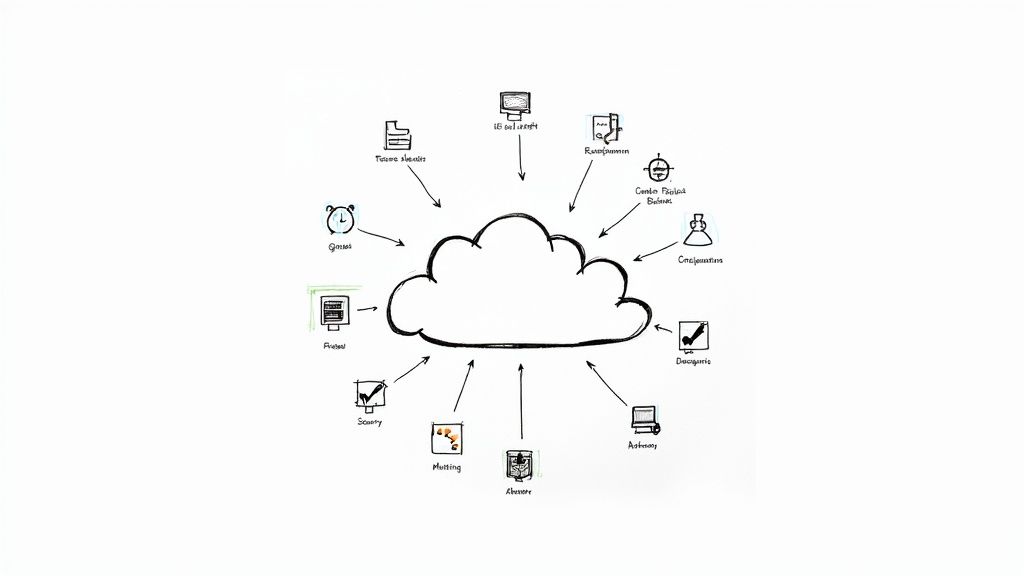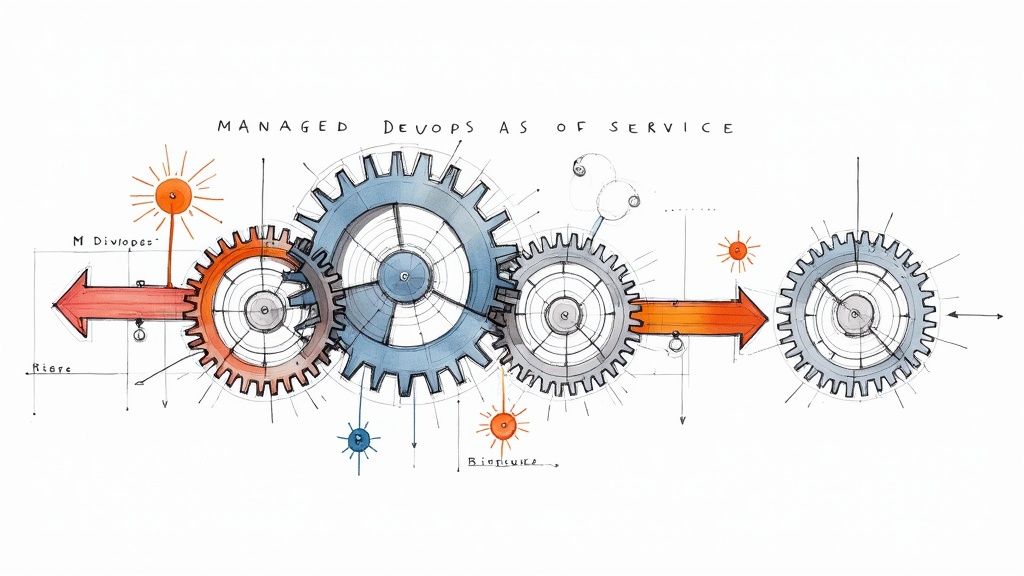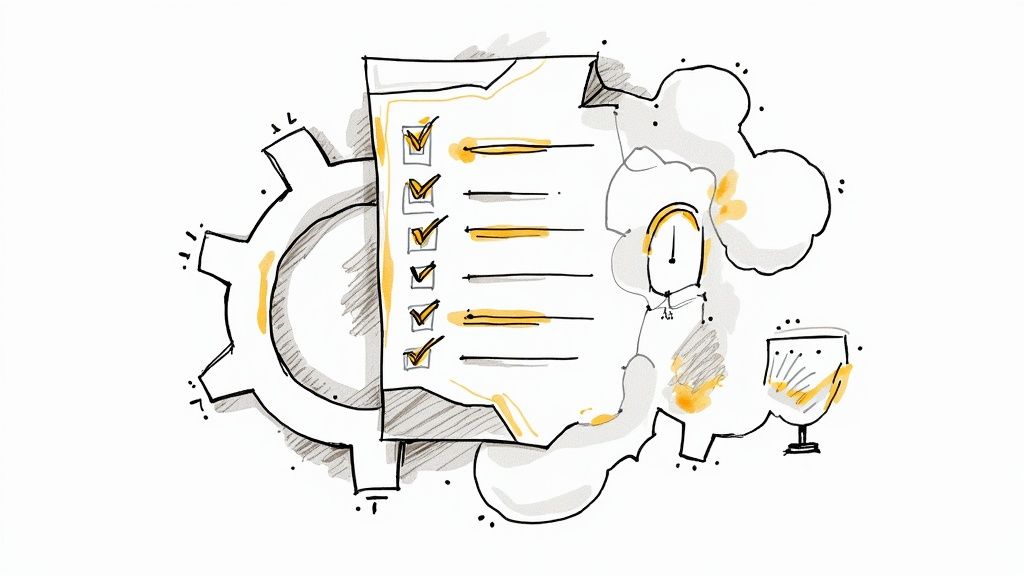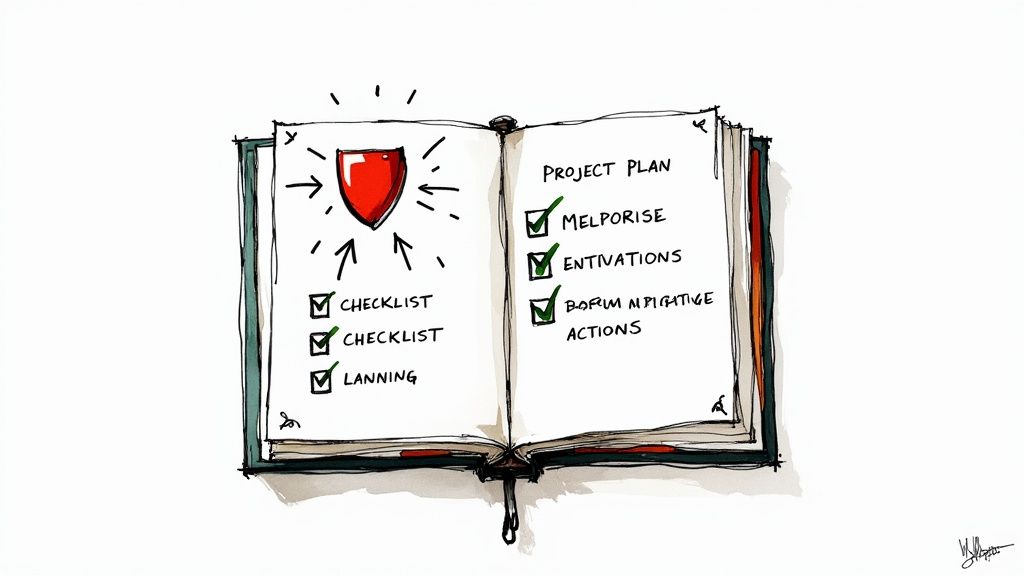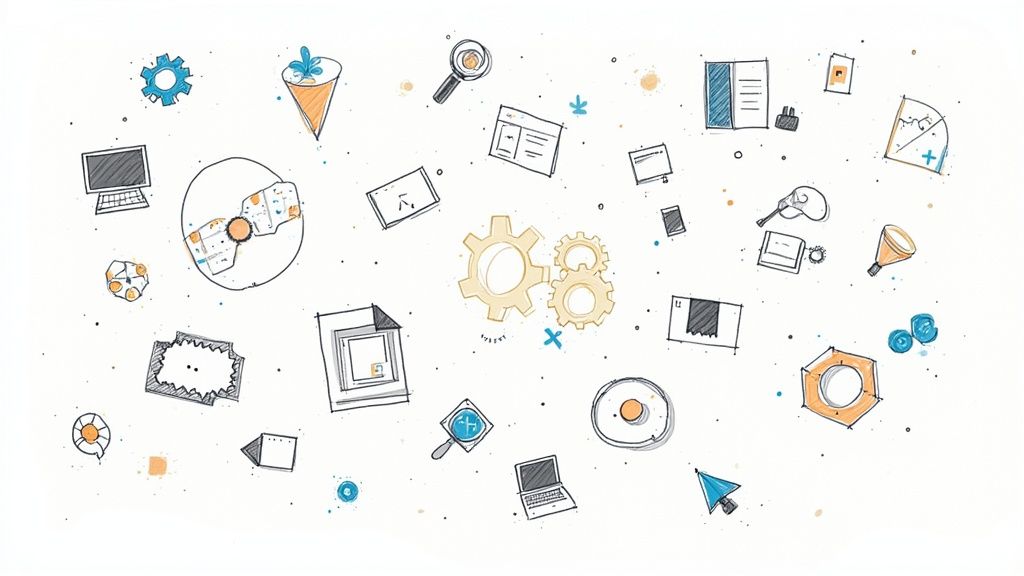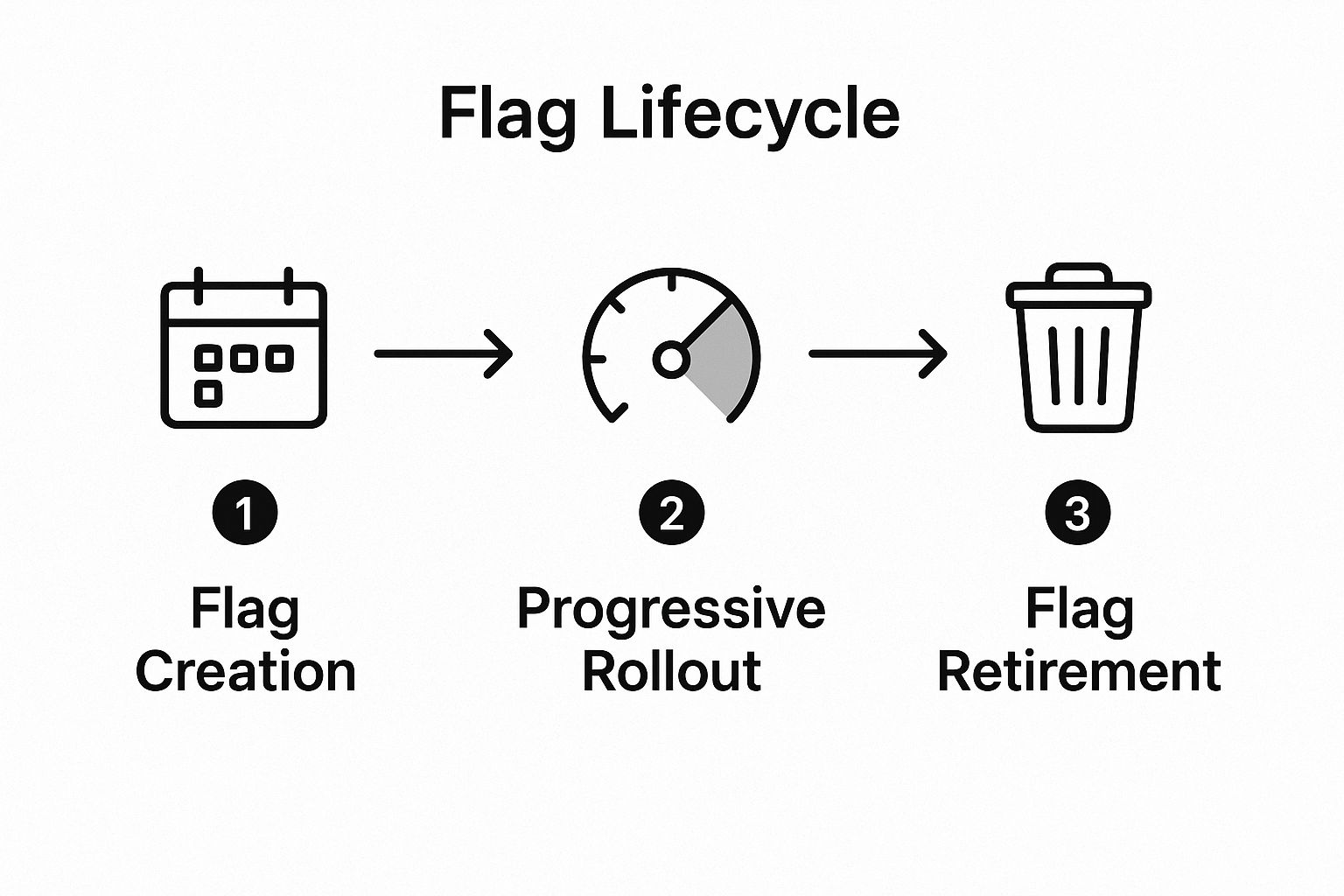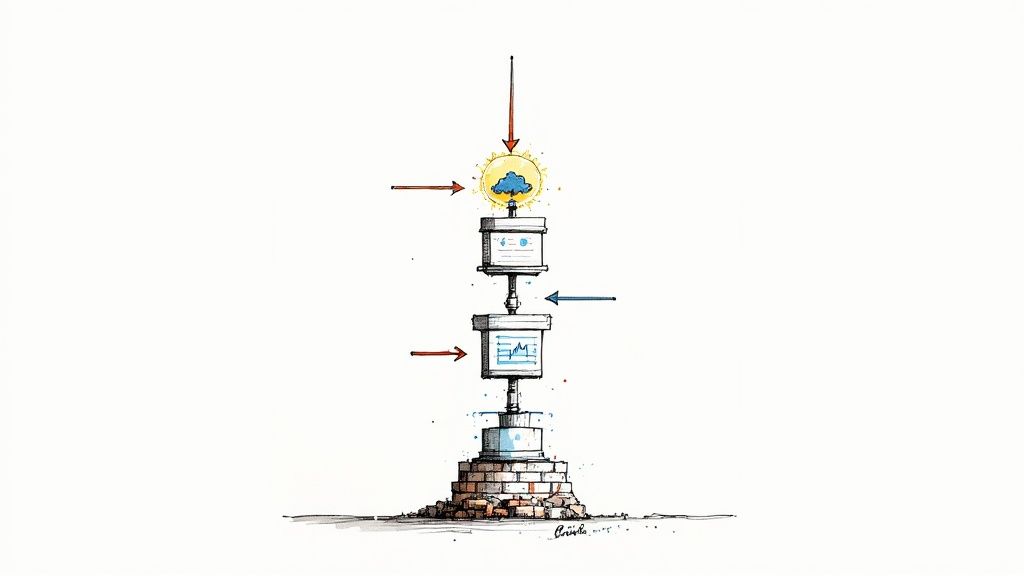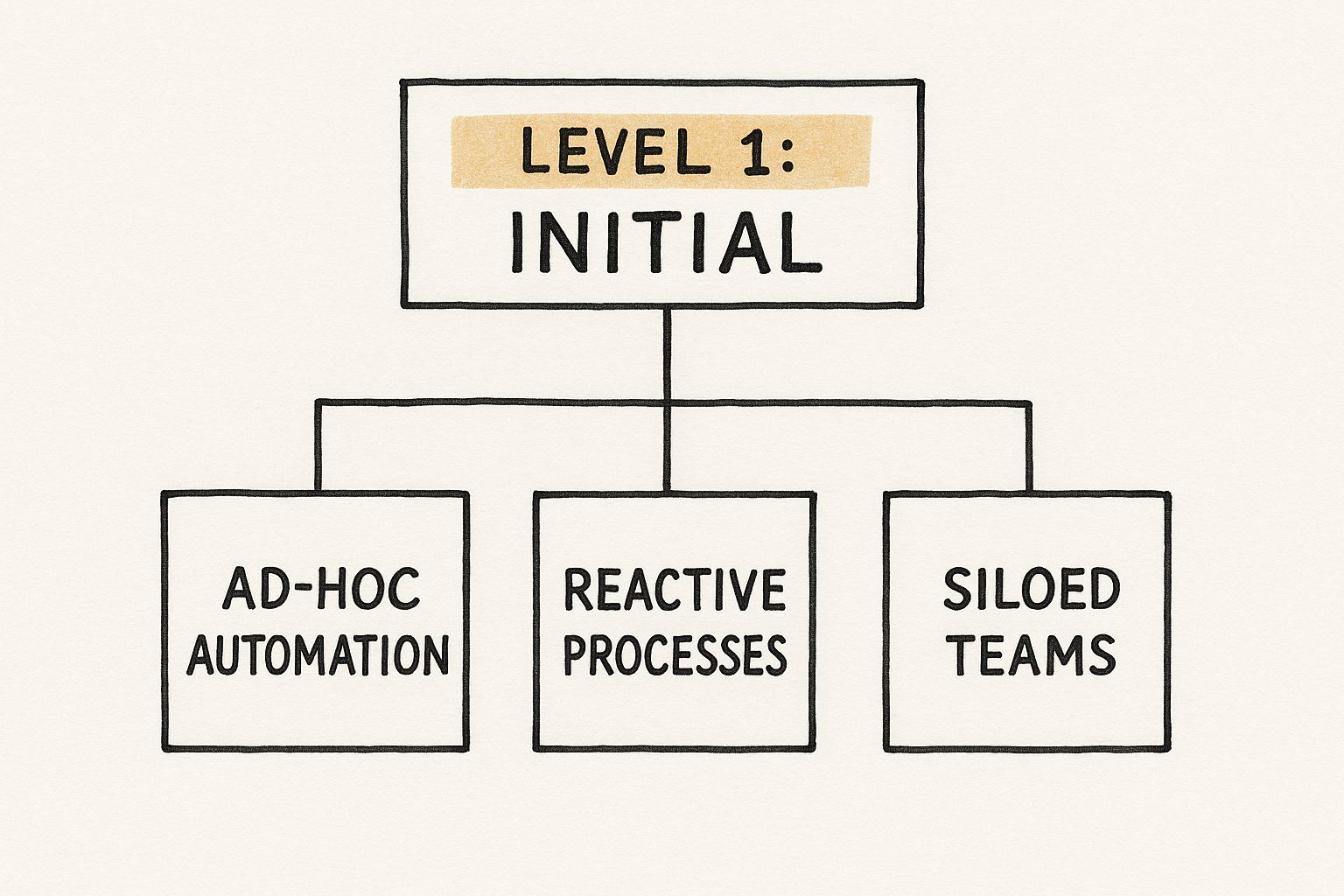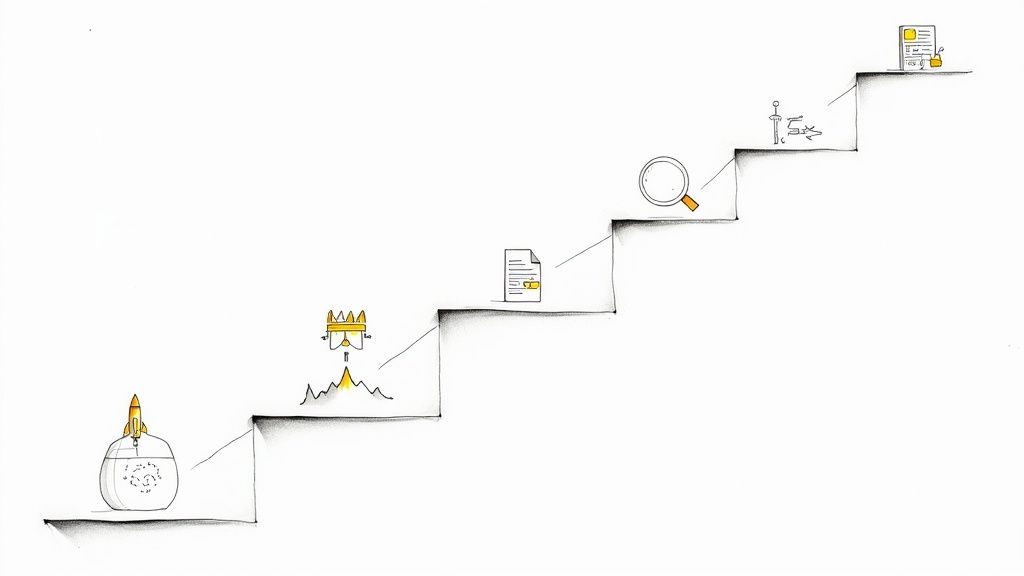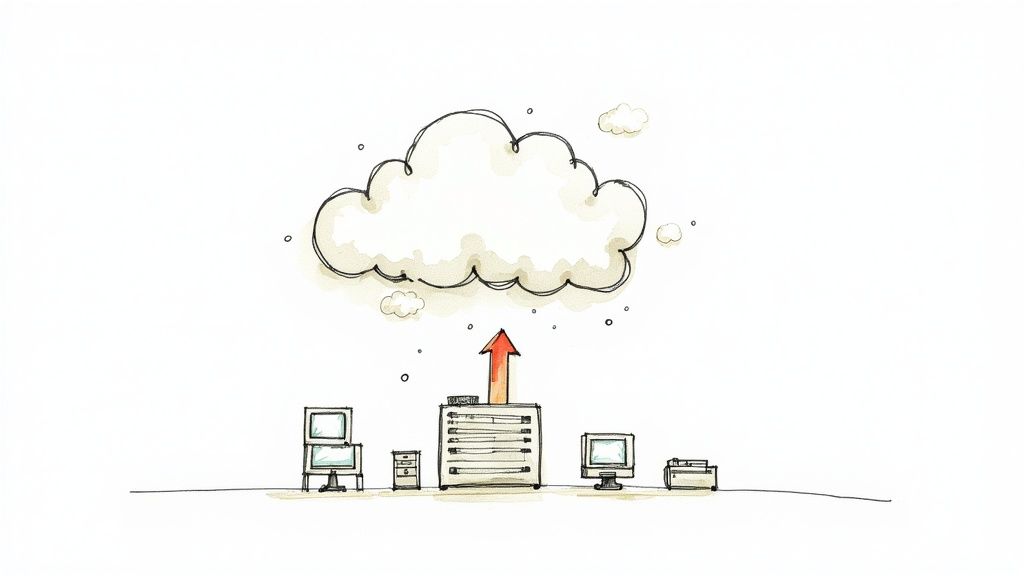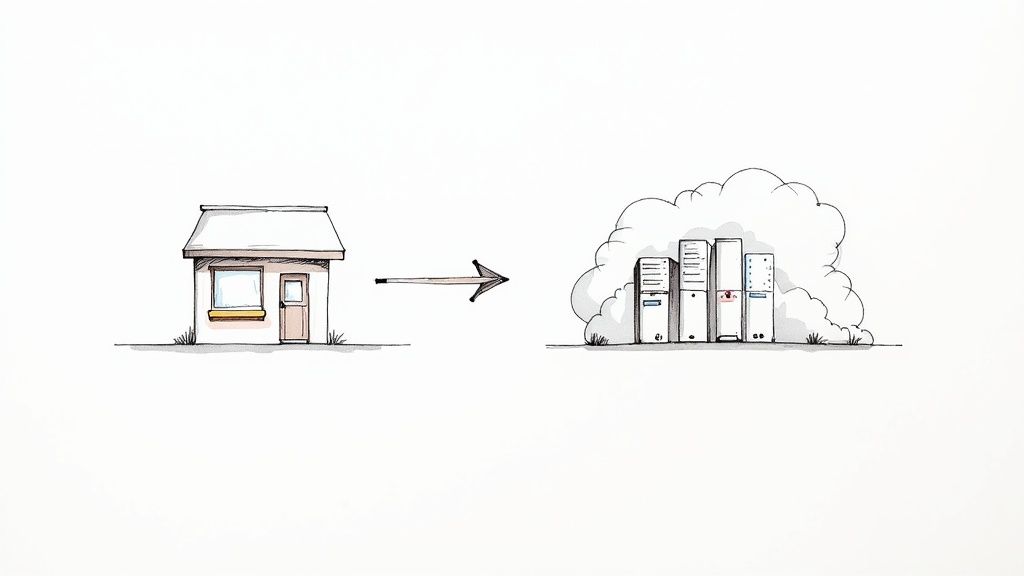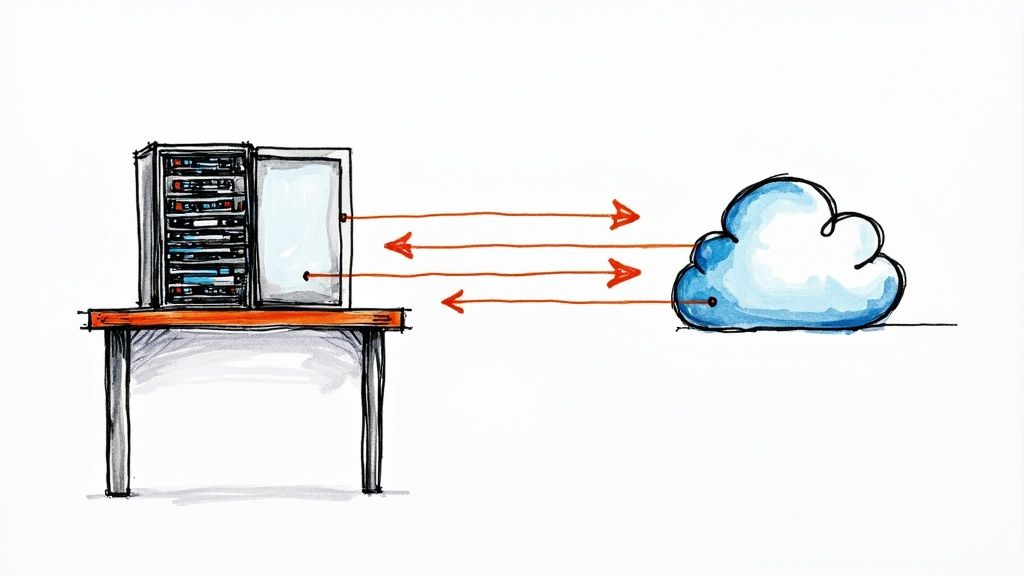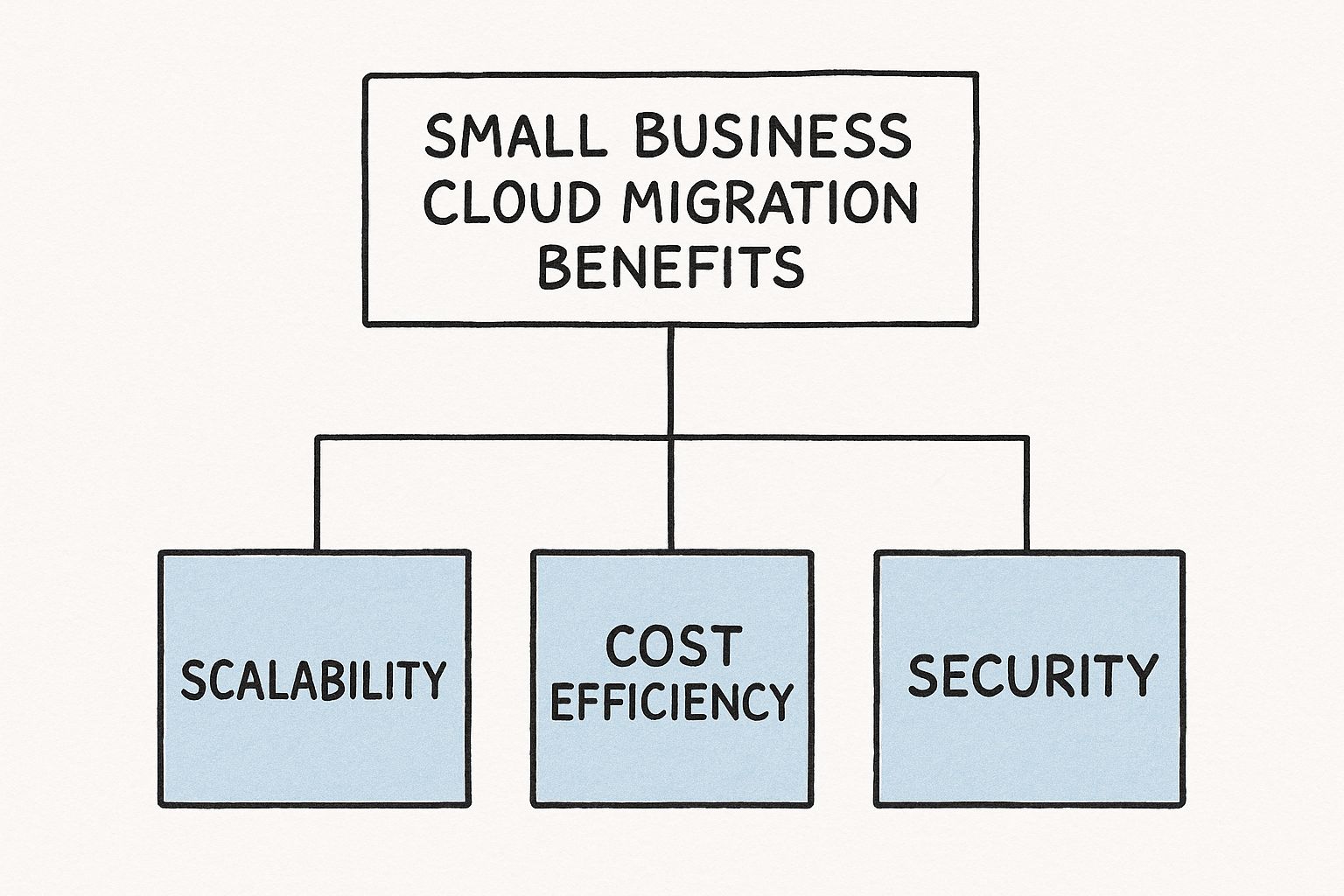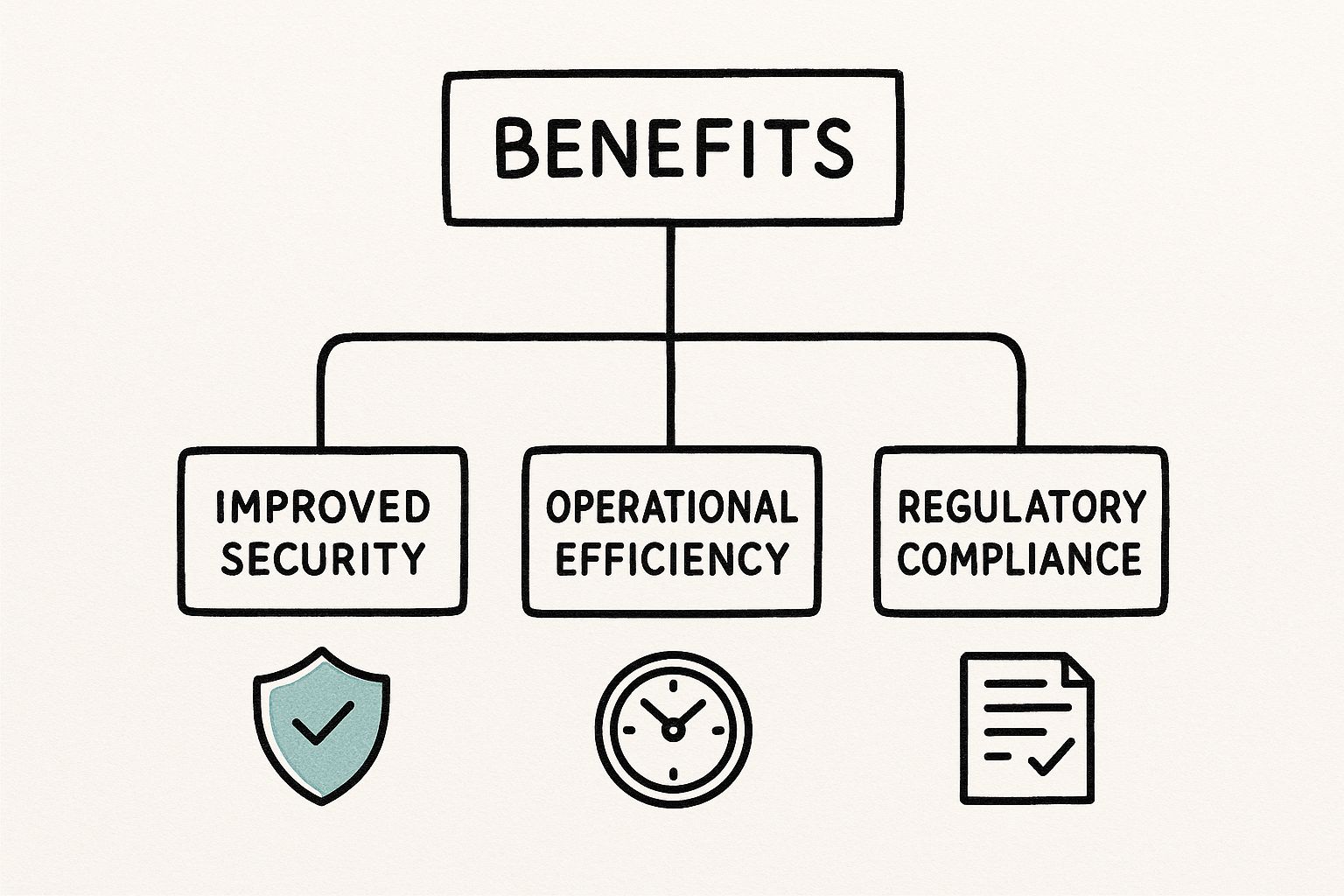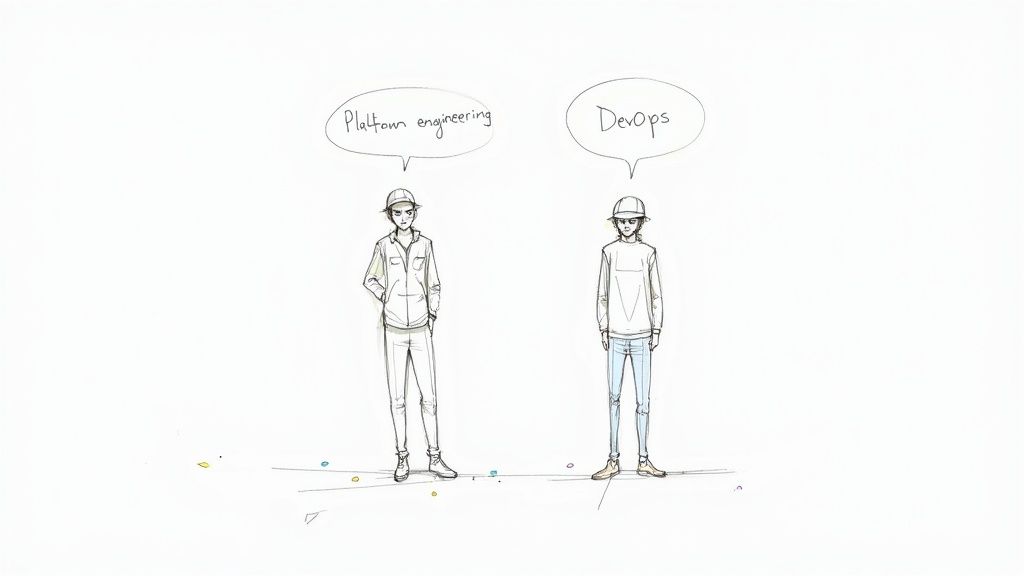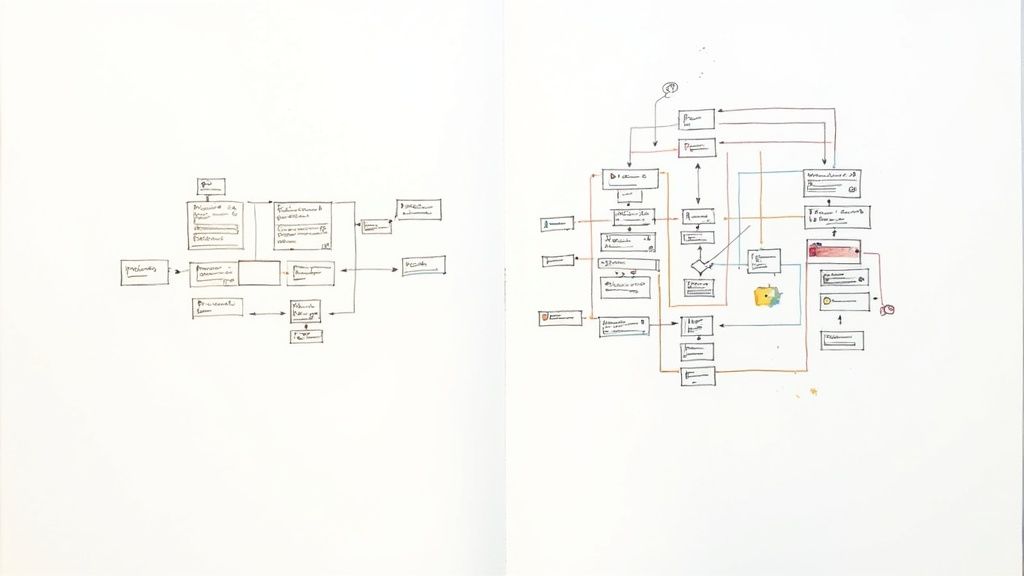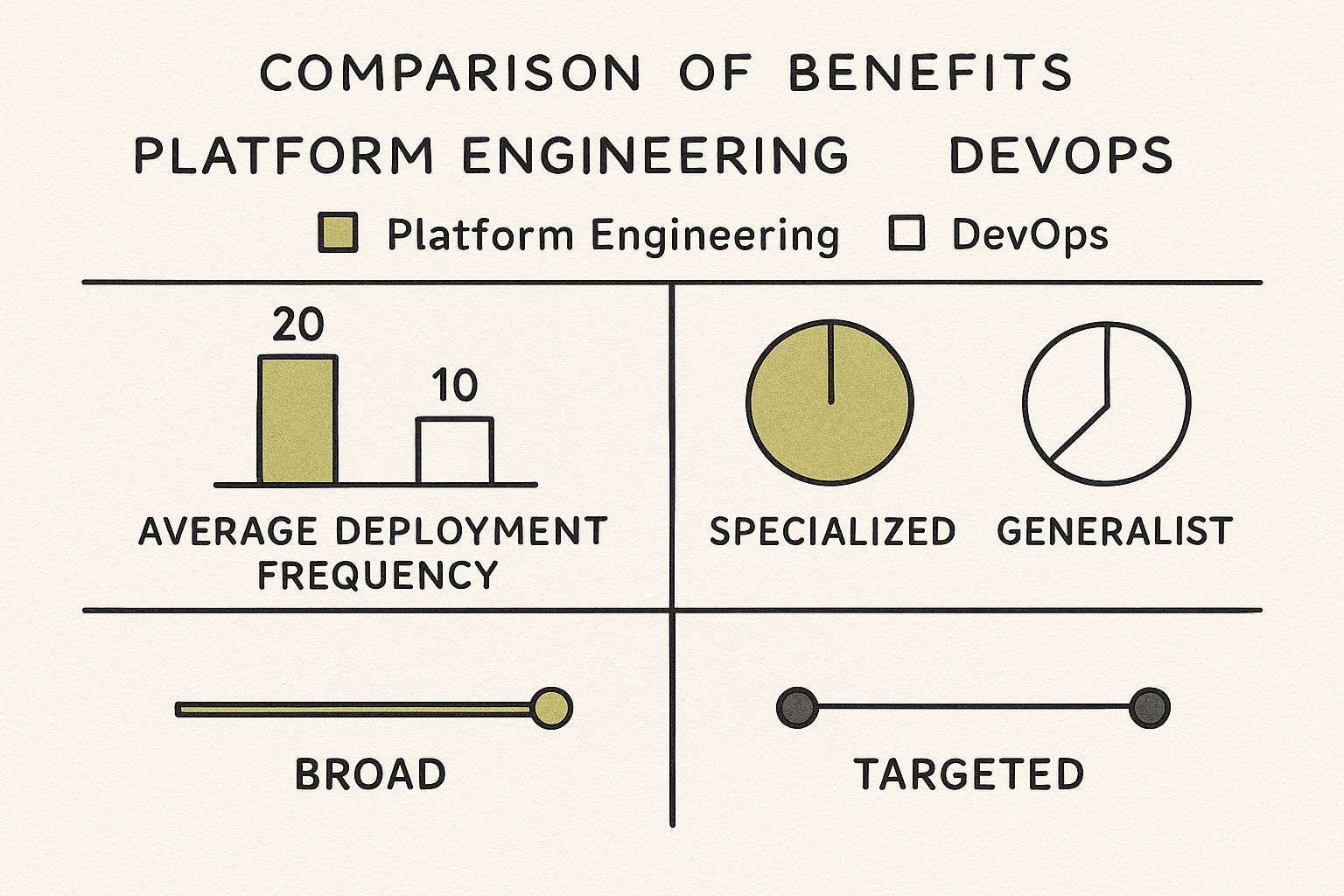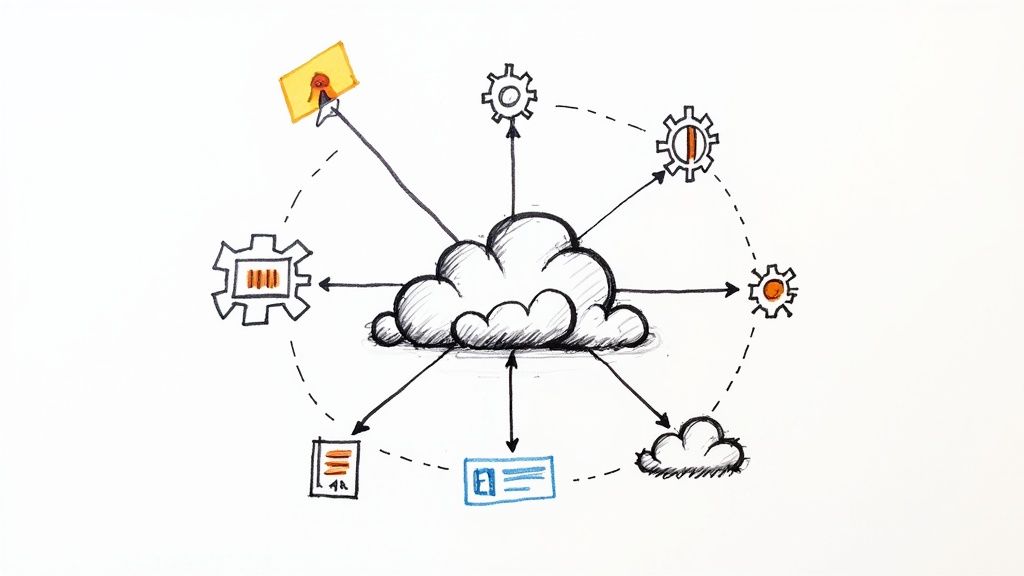Transitioning infrastructure to the cloud is no longer a strategic option; it's a core operational necessity for scalability, resilience, and performance. However, a successful migration is far from a simple lift-and-shift operation. It's a complex, multi-stage process where selecting the right tooling can mean the difference between a seamless transition and a costly failure marked by extended downtime, data loss, and security vulnerabilities. This is precisely why a deep understanding of the best cloud migration tools is critical for any technical leader, from startup CTOs to enterprise IT managers.
This guide moves beyond generic marketing claims to provide a technical, actionable breakdown of the top-tier solutions available today. We dissect the capabilities of native hyperscaler services like AWS Application Migration Service and Azure Migrate, specialized third-party platforms such as Zerto and RackWare, and crucial planning tools like Flexera One and Device42. Our goal is to equip you with the specific insights needed to map your technical requirements, from application dependency mapping to post-migration validation, to the right toolset.
Each entry in this listicle includes a detailed analysis of key features, practical use-case scenarios, and an honest look at potential limitations. As you evaluate these tools, remember that data governance and security are paramount. It's crucial to review privacy policies related to cloud migration to ensure compliance and data protection throughout the process. This comprehensive resource, complete with direct links and screenshots, will help you navigate the intricate landscape and select the optimal tools for a successful, efficient, and secure cloud migration.
1. AWS Application Migration Service (AWS MGN)
AWS Application Migration Service (MGN) is the primary "lift-and-shift" tool recommended by Amazon for rehosting a wide range of applications into its ecosystem. It excels at replicating physical, virtual, or other cloud-based servers into native Amazon EC2 instances with minimal disruption. The service is designed for speed and simplicity, making it a cornerstone of many large-scale AWS migration projects and one of the best cloud migration tools for teams committed to the AWS platform.
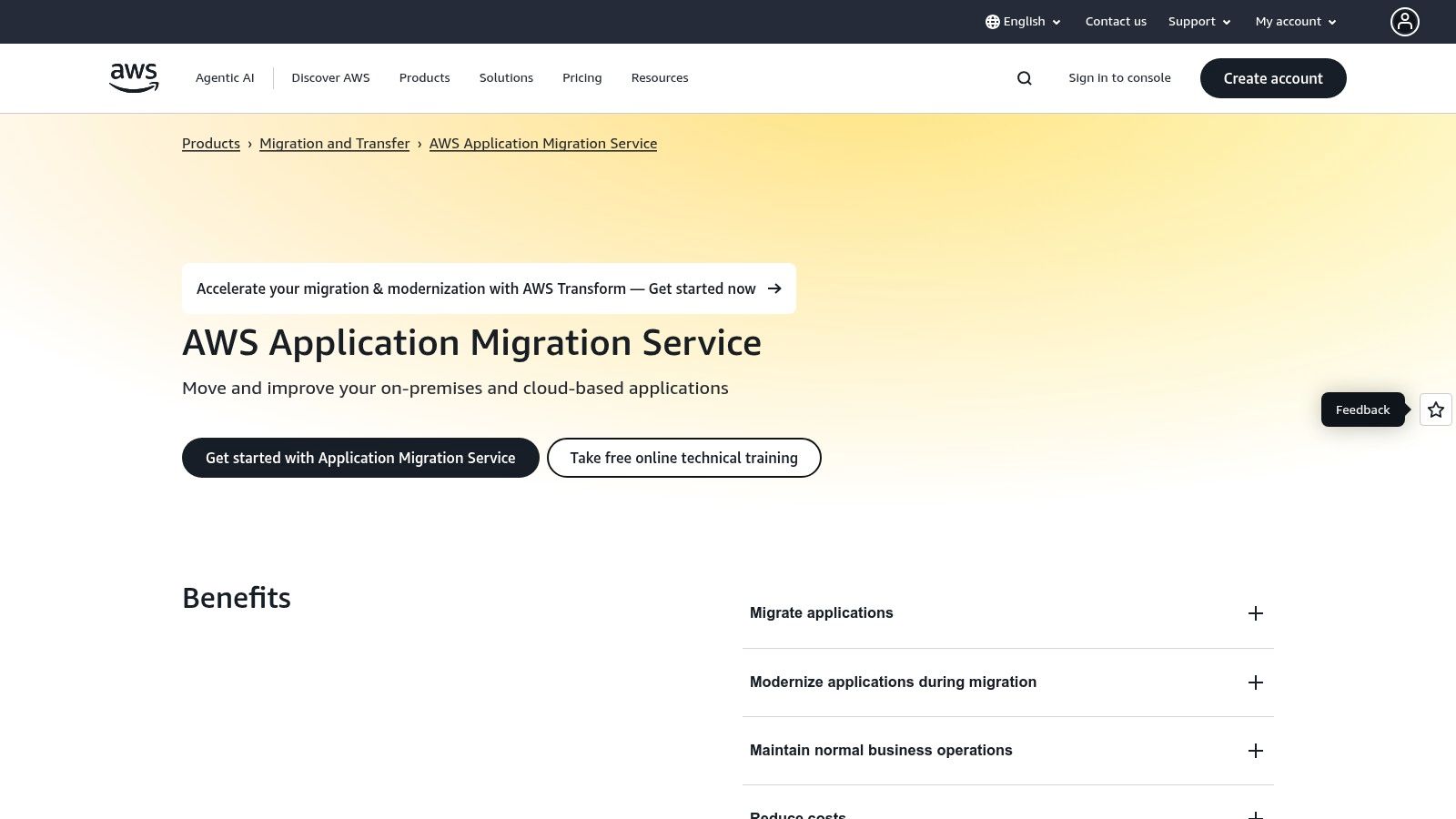
The core mechanism of AWS MGN is its continuous, block-level data replication. After installing a lightweight agent on a source server, MGN begins copying the entire disk volume to a staging area in your target AWS account. This process happens in the background without impacting source machine performance, ensuring data consistency right up to the point of cutover. This approach is highly effective for migrating complex, stateful applications like databases or legacy enterprise systems where downtime must be kept to an absolute minimum.
Key Features & Use Cases
- Automated Conversion & Cutover: MGN automatically converts source machine boot volumes to run natively on EC2, handling driver and system configuration changes. This significantly reduces manual effort.
- Non-disruptive Testing: You can launch test instances at any time from the replicated data without affecting the source environment, allowing for thorough validation of application performance and dependencies.
- Centralized Management: A single console allows you to manage migrations for hundreds of servers across multiple AWS accounts, streamlining large-scale projects.
- Post-Migration Modernization Hooks: MGN integrates with other AWS services like App2Container, providing a pathway to containerize and modernize applications after the initial lift-and-shift is complete.
Pricing & Implementation
AWS offers MGN free of charge for a 90-day period for each server you migrate. However, you are responsible for the costs of the underlying AWS resources provisioned during this time, such as staging area EC2 instances and EBS volumes. For a detailed breakdown of how these costs are structured, you can learn more about small business cloud migration strategies. After 90 days, you will be billed per hour for each active source server.
| Pros | Cons |
|---|---|
| Deep, native integration with the AWS ecosystem. | Tightly coupled to AWS; not a cloud-agnostic solution. |
| Significant reduction in cutover downtime and manual processes. | Replication and testing can incur significant AWS resource costs. |
| Highly scalable for migrating hundreds of servers simultaneously. | The lightweight agent still requires access and installation on all source machines. |
Best for: Organizations of any size that are committed to migrating workloads into the AWS cloud and prioritize minimizing downtime and manual reconfiguration. It is especially powerful for rehosting traditional enterprise applications, databases, and multi-tier systems.
Visit AWS Application Migration Service (MGN) Website
2. Azure Migrate
Azure Migrate is Microsoft's centralized hub for managing the entire cloud migration and modernization journey into the Azure cloud. It serves as a unified platform that brings together native Azure tools and integrated third-party ISV offerings to handle discovery, assessment, and migration of on-premises infrastructure, applications, and data. This comprehensive approach makes it one of the best cloud migration tools for organizations standardizing on the Microsoft ecosystem.
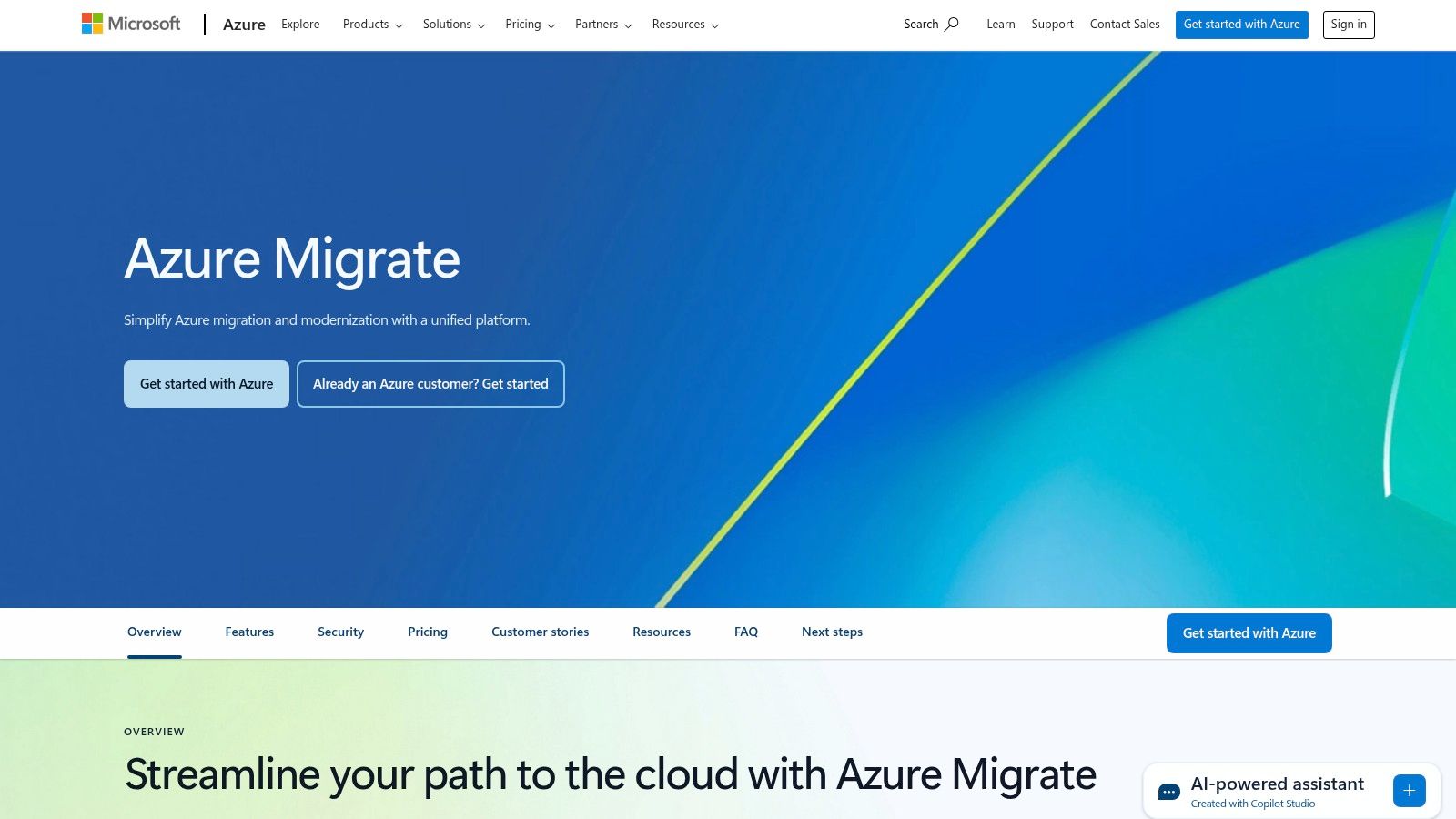
The platform's strength lies in its extensive assessment capabilities. Before moving a single workload, Azure Migrate can perform agentless discovery of your VMware or Hyper-V environments, physical servers, and even other public clouds. It then provides detailed readiness assessments, performance-based right-sizing recommendations, and granular cost estimations, allowing you to build a data-driven business case for your migration. This robust planning phase is crucial for avoiding unexpected costs and performance issues post-migration.
Key Features & Use Cases
- Integrated Toolset: Provides a single portal for server, database, data box, web app, and virtual desktop migrations, creating a cohesive user experience.
- Agentless Discovery & Dependency Mapping: Identifies on-premises servers and visualizes application dependencies without requiring agent installation on every machine, simplifying the assessment of complex environments.
- Comprehensive Assessment: Delivers detailed reports on Azure readiness, right-sizing recommendations for VMs, and cost projections to inform your migration strategy.
- Third-Party Tool Integration: Seamlessly integrates with tools from vendors like Carbonite and RackWare, allowing teams to use familiar solutions within the Azure Migrate framework.
Pricing & Implementation
The core Azure Migrate discovery and assessment tools are provided free of charge. However, costs are incurred for the underlying Azure resources used during the migration process itself, such as replication storage and test instances. While many first-party migration tools have free tiers, some third-party ISV tools integrated into the platform may require separate licensing. You can learn more about how to structure your Azure migration to optimize these costs.
| Pros | Cons |
|---|---|
| Central dashboard simplifies management of complex migrations. | Third-party ISV add-ons can increase overall cost and complexity. |
| Powerful, free assessment tools for planning and cost analysis. | Primarily designed for Azure; not a multi-cloud migration solution. |
| Deep integration with the entire Azure and Microsoft ecosystem. | Replication costs for services like Azure Site Recovery can apply after initial free periods. |
Best for: Businesses heavily invested in the Microsoft stack or those planning a comprehensive, large-scale migration to Azure. Its powerful, free assessment capabilities are invaluable for organizations that need to build a detailed, data-driven migration plan before committing resources.
3. Google Cloud Migration Center + Migrate to Virtual Machines
Google Cloud Migration Center serves as a comprehensive hub integrated directly into the Google Cloud Console, designed to guide organizations through their entire migration journey. It combines assessment, planning, and execution tools, with Migrate to Virtual Machines acting as its primary engine for "lift-and-shift" operations. This unified approach provides a centralized platform to discover on-premises or other cloud assets, analyze total cost of ownership (TCO), and execute migrations into Google Compute Engine, making it one of the best cloud migration tools for teams adopting the GCP ecosystem.
The core technology behind Migrate to Virtual Machines leverages streaming and caching capabilities to decouple the migration process from the source environment. This allows for near-zero downtime during cutover, as workloads can be running in the cloud from replicated data while the final data synchronization completes in the background. This methodology is particularly effective for migrating business-critical applications where minimizing service interruption is a top priority.
Key Features & Use Cases
- Integrated Discovery & Assessment: The Migration Center can automatically discover assets in your environment (like vSphere), assess their readiness for GCP, and provide rightsizing recommendations and cost estimates.
- Test-Clone Functionality: You can create a fully functional clone of a source VM in Google Cloud for testing purposes without impacting the production environment, ensuring application compatibility and performance validation.
- Phased, Controlled Cutover: The service enables a "wave-based" migration strategy, allowing you to move groups of servers in controlled phases with built-in rollback capabilities for a secure transition.
- End-to-End Migration Management: From initial discovery and TCO analysis to the final cutover, the entire process is managed and monitored within a single, unified interface in the Google Cloud Console.
Pricing & Implementation
The Migrate to Virtual Machines service itself is offered at no charge for migrating workloads into Google Cloud. However, you are responsible for the costs of all standard GCP resources used during the migration and for running the migrated workloads. This includes Compute Engine instances, Persistent Disk storage, and networking resources consumed during testing and post-cutover.
| Pros | Cons |
|---|---|
| Tightly integrated, end-to-end migration tooling within GCP. | Purpose-built for Google Cloud; not a multi-cloud migration solution. |
| No additional licensing fees for the migration service itself. | Standard GCP resource charges for compute and storage apply during the process. |
| Enables near-zero downtime migrations through data streaming. | Relies on access to the source environment (e.g., vCenter) for discovery. |
Best for: Businesses migrating virtualized workloads, particularly from VMware vSphere environments, into Google Cloud. Its integrated assessment, planning, and execution capabilities make it ideal for organizations seeking a streamlined, all-in-one migration experience managed directly from the GCP console.
Visit Google Cloud Migration Center Website
4. VMware HCX
VMware HCX (Hybrid Cloud Extension) is an application mobility platform designed for simplifying workload migration, rebalancing, and business continuity across data centers and clouds. It specializes in large-scale, live migrations of vSphere workloads, making it a powerful tool for organizations heavily invested in the VMware ecosystem. By abstracting the vSphere environment from the underlying physical hardware or cloud provider, HCX enables seamless workload movement without significant reconfiguration or downtime.

The platform's strength lies in its ability to create a secure and optimized network fabric between disparate environments. This allows for live vMotion of single virtual machines or bulk migration of hundreds of VMs simultaneously. Its built-in WAN optimization and traffic engineering capabilities ensure that migration performance is maximized, even over connections with high latency. This makes it one of the best cloud migration tools for complex data center evacuations or hybrid cloud deployments.
Key Features & Use Cases
- Advanced Migration Types: Supports multiple migration methods including live vMotion, bulk migration for parallel moves, and Replication Assisted vMotion (RAV) for moving workloads with minimal downtime.
- Layer-2 Network Extension: Stretches Layer-2 networks from an on-premises data center to the cloud, allowing VMs to be migrated without changing their IP addresses, which drastically simplifies the process.
- WAN Optimization: Includes integrated WAN conditioning to reduce the impact of latency and improve data transfer rates over the interconnect between sites.
- Multi-Cloud Mobility: Facilitates workload movement between on-premises vSphere environments and VMware-based clouds like VMware Cloud on AWS, Azure VMware Solution, and Google Cloud VMware Engine.
Pricing & Implementation
VMware HCX is typically bundled as part of broader VMware software-defined data center (SDDC) packages or cloud provider offerings, such as VMware Cloud Foundation. Its availability and licensing costs are often integrated into the subscription for a VMware-based cloud service. Implementation requires deploying the HCX Manager appliance at both the source and destination sites and establishing a service mesh between them.
| Pros | Cons |
|---|---|
| Large-scale, low-downtime migration across mixed vSphere versions. | Best fit for VMware-centric environments; not a cloud-agnostic tool. |
| Strong, native integration with the entire VMware ecosystem. | Licensing and cost can be complex, often tied to larger VMware bundles. |
| Eliminates the need to re-IP applications via network extension. | Initial setup of the service mesh can be technically intensive. |
Best for: Enterprises with significant investments in VMware vSphere looking to migrate workloads to a VMware-based public or private cloud. It is ideal for data center consolidation projects, disaster recovery planning, and establishing long-term hybrid cloud architectures.
5. OpenText Migrate (formerly Carbonite Migrate)
OpenText Migrate, built on the well-regarded Carbonite Migrate technology, provides a versatile, hardware-agnostic solution for moving workloads with near-zero downtime. It specializes in migrating physical, virtual, and cloud-based servers to any target environment, including AWS, Azure, Google Cloud, and private data centers. This flexibility makes it one of the best cloud migration tools for complex, hybrid, and multi-cloud strategies where vendor lock-in is a primary concern.
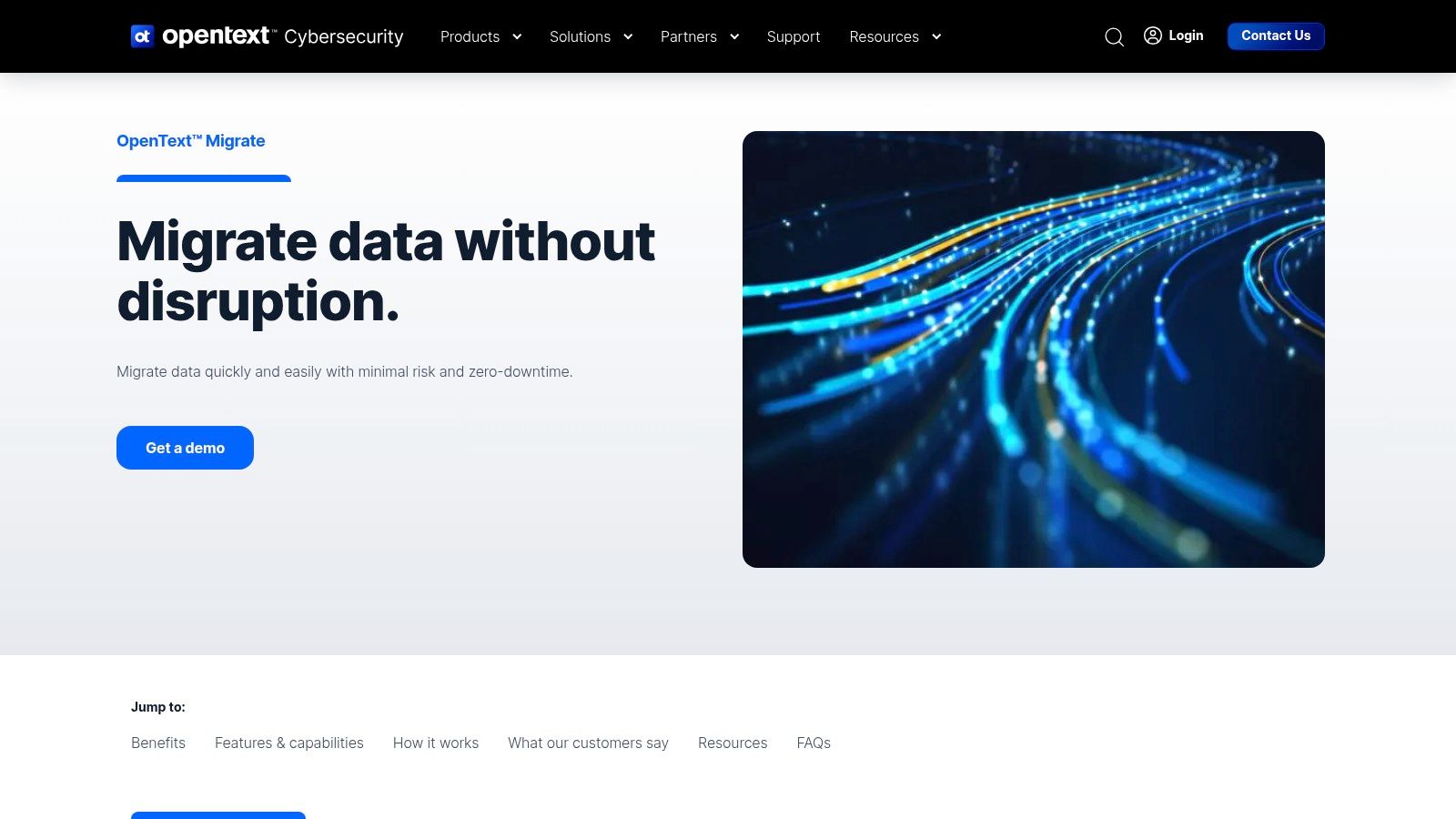
The platform leverages continuous, real-time, byte-level replication to create an exact replica of the source server's data, applications, and operating system on the target system. This process occurs in the background with minimal performance impact, ensuring business continuity. Its strength lies in its ability to orchestrate complex cutovers, allowing teams to pre-configure and automate the entire migration sequence for multi-tier applications, ensuring all components come online in the correct order.
Key Features & Use Cases
- Any-to-Any Migration: Supports a wide array of source and target platforms, including physical servers, VMware, Hyper-V, AWS, Azure, and Google Cloud Platform.
- Orchestrated Cutover: Automates migration workflows, allowing for repeatable and predictable cutovers that can be tested non-disruptively before the final switch.
- Data Throttling & Compression: Provides granular control over bandwidth usage to minimize the impact of data replication on production network performance.
- Automated Rollback: Offers a safety net by enabling quick and easy rollback to the original source system if any issues arise post-migration.
Pricing & Implementation
OpenText does not publish pricing for Migrate publicly. Costs are quote-based and depend on the scope of the migration project, including the number of servers and the support level required. Implementation typically involves deploying lightweight agents on source servers and a central management console to configure and monitor replication jobs. You must contact their sales team for a personalized quote.
| Pros | Cons |
|---|---|
| Platform-agnostic, supporting virtually any source and target. | Pricing is not transparent and requires direct sales engagement. |
| Repeatable workflows are ideal for large-scale migration programs. | OpenText’s broader product portfolio can be complex to navigate. |
| Strong reputation for reliability from its Carbonite heritage. | Requires agent installation on all source machines. |
Best for: Enterprises executing complex, large-scale migrations across hybrid or multi-cloud environments. Its powerful orchestration and any-to-any flexibility are particularly valuable for moving interdependent, multi-tier applications with stringent uptime requirements.
Visit OpenText Migrate Website
6. Zerto (by HPE) – Migration & Workload Mobility
Zerto, an HPE company, offers a platform built on a foundation of Continuous Data Protection (CDP) that excels in workload mobility and disaster recovery. While renowned for its DR capabilities, Zerto’s core technology makes it one of the best cloud migration tools for scenarios demanding near-zero downtime and high resilience. It enables seamless migration of virtualized applications across on-premises data centers, private clouds, and major public cloud providers like AWS and Azure.
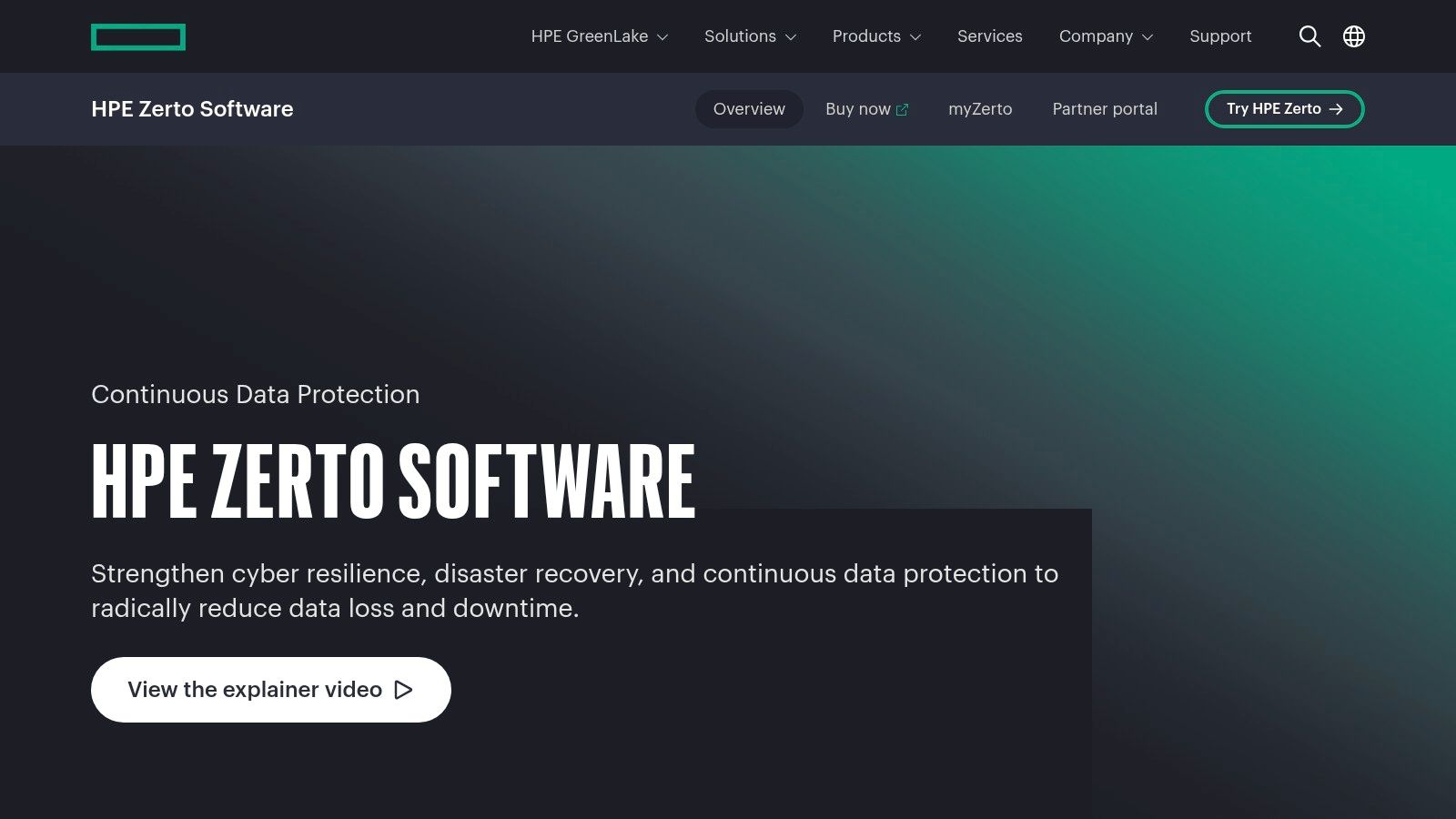
The platform operates using "always-on" replication, capturing and sending every data change from a source VM to a target site with a recovery point objective (RPO) of seconds. This hypervisor-based replication is application-agnostic, meaning it can protect and move complex, multi-VM applications without requiring in-guest agents. This approach ensures that entire application stacks, including their intricate dependencies and boot order, are migrated as a single, consistent entity.
Key Features & Use Cases
- Vendor-Agnostic Mobility: Zerto is not locked into a single ecosystem, allowing you to migrate workloads between VMware, Hyper-V, AWS, and Azure environments as your business needs evolve.
- Non-disruptive Testing & Failover: You can conduct unlimited migration tests in isolated network "bubbles" at the target site without impacting production workloads, ensuring predictable cutover outcomes.
- One-Click Rollback: In the event of a migration issue, Zerto’s journal-based recovery allows you to instantly roll back to the pre-cutover state, providing a powerful safety net.
- Unified Platform: Zerto combines disaster recovery, backup, and cloud migration into a single management interface, reducing tool sprawl and simplifying IT operations.
Pricing & Implementation
Zerto is an enterprise-grade solution typically sold through partners and licensed based on the number of virtual machines being protected or migrated. Pricing is not publicly listed and requires a custom quote based on your specific environment and use case. Implementation involves deploying Zerto Virtual Managers and Virtual Replication Appliances (VRAs) at both the source and target sites. For complex workloads, understanding database migration best practices can help ensure data integrity during the process.
| Pros | Cons |
|---|---|
| Extremely low RPOs (seconds) minimize data loss during cutover. | Enterprise licensing model can be a significant investment. |
| Excellent support for hybrid and multi-cloud mobility. | Requires careful planning to align protection groups with migration waves. |
| Powerful, non-disruptive testing and one-click rollback capabilities. | The initial setup of replication appliances can be complex in large environments. |
Best for: Enterprises executing complex, multi-cloud, or hybrid-cloud migrations where minimizing downtime and data loss is a critical business requirement. It is especially effective for migrating stateful, multi-VM enterprise applications that require strong recovery and testing assurances.
7. RackWare Migration (RMM)
RackWare Migration (RMM) is a highly versatile and cloud-agnostic migration platform known for its ability to handle complex, heterogeneous environments. Unlike tools tied to a specific cloud provider, RMM provides an agentless "any-to-any" migration capability, allowing businesses to move physical servers, VMs, and even Kubernetes workloads between different public clouds like AWS, Azure, GCP, OCI, and on-premises data centers with a single solution. This flexibility makes it one of the best cloud migration tools for enterprises managing hybrid or multi-cloud strategies.
RMM operates by taking a complete snapshot of a live source machine, including its OS, applications, and data, without installing persistent agents. It then provisions a target VM in the destination cloud and synchronizes the data. The platform’s delta sync feature ensures data remains current until the final cutover, which minimizes downtime and allows for scheduled migration waves. This method is particularly effective for large-scale, phased migrations where control and planning are paramount.
Key Features & Use Cases
- Any-to-Any Replication: Supports migrations between any combination of physical servers, hypervisors (VMware, Hyper-V), and major cloud platforms, offering true infrastructure freedom.
- Assessment & Cost Modeling: Includes a free assessment module that analyzes source workloads to provide right-sized server recommendations and detailed cost projections for the target cloud.
- Automated Runbook & Scheduling: Enables the creation of migration "waves," allowing teams to automate and schedule large-scale moves with pre-defined cutover windows and rollback plans.
- Disaster Recovery Integration: The same replication technology can be used to configure a cloud-based disaster recovery (DR) solution, providing additional value beyond the initial migration project.
Pricing & Implementation
RackWare’s pricing is license-based and is often available through the marketplaces of major cloud providers like AWS, Azure, and Oracle. This allows organizations to leverage existing cloud commitments and simplify procurement. The licensing model is typically structured per server migrated, with different tiers available based on the scale and complexity of the migration program. The initial assessment and discovery functions are often provided free of charge.
| Pros | Cons |
|---|---|
| Truly cloud-agnostic, supporting complex hybrid and multi-cloud moves. | Higher operational overhead makes it less ideal for small, one-off projects. |
| Agentless approach simplifies deployment on locked-down or legacy systems. | The feature set can be overwhelming for teams needing a simple lift-and-shift tool. |
| Strong capabilities for regulated industries requiring detailed planning and rollback. | Licensing costs are an added expense on top of cloud resource consumption. |
Best for: Large enterprises, managed service providers, and organizations in regulated industries that need a robust, unified platform for complex, multi-workload migrations across diverse cloud and on-premises environments. It excels in scenarios requiring detailed planning, scheduling, and disaster recovery capabilities.
Visit RackWare Migration (RMM) Website
8. RiverMeadow Workload Mobility Platform
RiverMeadow offers a comprehensive Workload Mobility Platform designed to handle the entire migration lifecycle, from discovery and assessment to the final cutover. Available as both a SaaS and a private-deployable solution, it provides a flexible framework for rehosting and replatforming workloads, with a particular strength in complex VMware-to-cloud migrations. Its holistic approach, combining discovery, rightsizing, and migration execution, positions it as one of the best cloud migration tools for enterprises seeking a structured, multi-phase migration strategy.
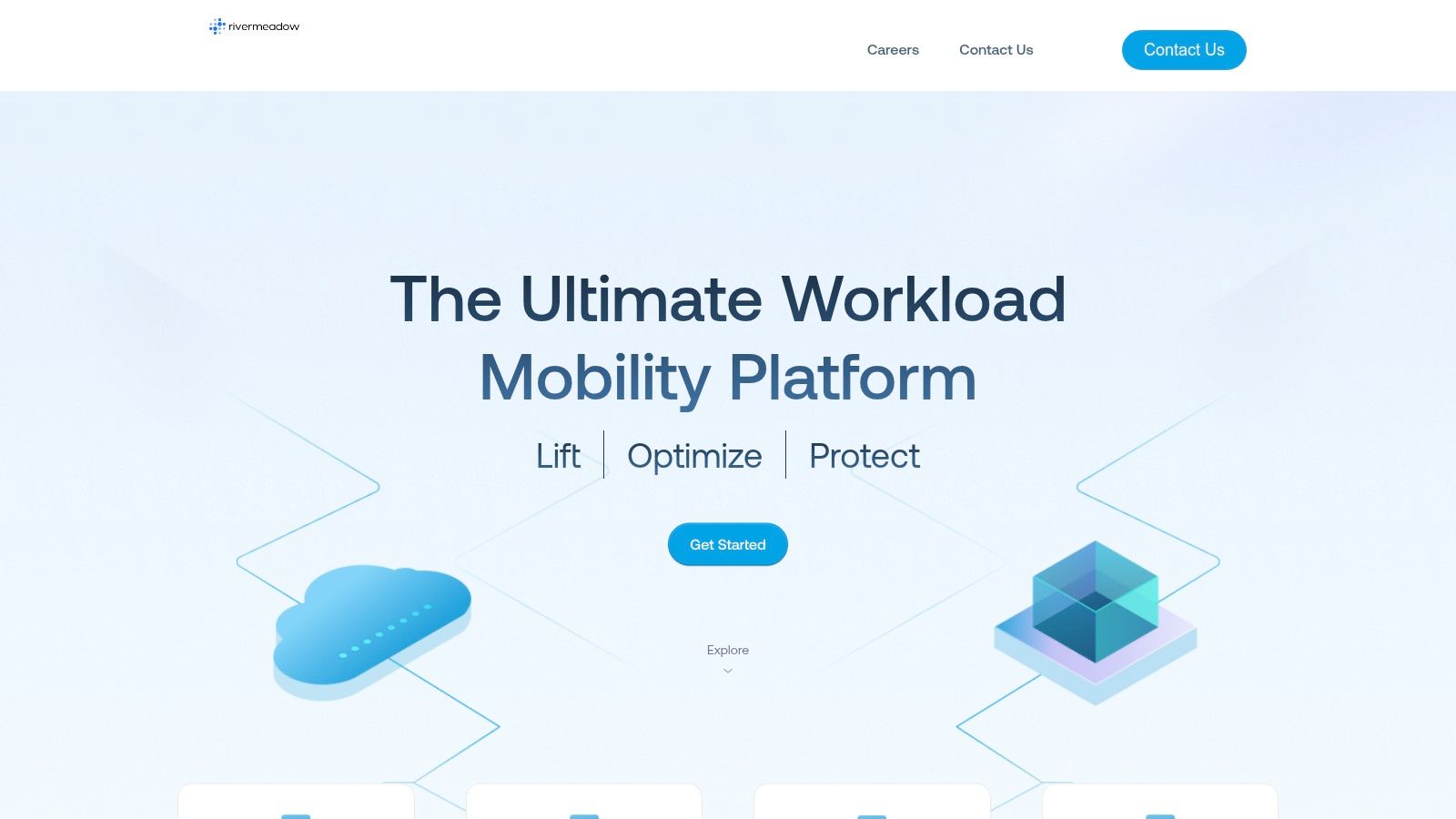
The platform stands out by giving users a choice between a self-service model, where internal IT teams drive the process, and fully managed migration services. This flexibility allows organizations to tailor their approach based on internal expertise and resource availability. RiverMeadow’s discovery capabilities provide deep application insights and dependency mapping, which are crucial for creating logical move groups and orchestrating migration waves with minimal business disruption.
Key Features & Use Cases
- Multi-Cloud/Multi-Platform Support: Supports migrations from any source (physical, virtual, cloud) to any major cloud, including AWS, Azure, and Google Cloud.
- Discovery & Wave Planning: Automates the collection of workload inventory and dependency data to facilitate rightsizing and the strategic planning of migration waves.
- Self-Service & Managed Options: Offers migration entitlements for self-service use or can be paired with managed services for a hands-off, expert-led experience.
- Integrated Bundles: Partners with companies like MontyCloud to offer joint fixed-price bundles that cover both the migration and post-migration operational management.
Pricing & Implementation
RiverMeadow’s pricing is primarily enterprise-focused and often involves minimum purchase requirements. The platform is available directly through the AWS Marketplace, which can simplify procurement and billing for organizations already using AWS. Due to its tailored nature, detailed public pricing is limited, and prospective users will need to engage with their sales team for a custom quote based on the scope and scale of their migration project.
| Pros | Cons |
|---|---|
| Provides both self-service and expert-led managed service migration options. | Public pricing is limited; enterprise minimums apply. |
| Streamlined procurement via availability on the AWS Marketplace. | May be less accessible or cost-effective for small-scale migration needs. |
| Strong discovery and dependency mapping for strategic wave planning. | The comprehensive feature set can have a steeper learning curve for self-service. |
Best for: Enterprises and mid-sized companies executing complex, large-scale migrations, particularly from VMware environments, who require a versatile platform that supports both self-service and fully managed engagement models.
Visit RiverMeadow Workload Mobility Platform Website
9. Flexera One – Cloud Migration & Modernization (Planning)
Flexera One specializes in the critical, yet often overlooked, initial phases of a cloud migration: assessment and planning. Rather than a direct data replication tool, it serves as a powerful discovery and decision-making engine. It provides the deep visibility and financial modeling needed to build a data-driven migration strategy, making it one of the best cloud migration tools for enterprises seeking to de-risk complex, large-scale transformations before moving a single server.

The platform excels at creating a comprehensive inventory of your on-premises and hybrid IT estate, automatically mapping intricate application dependencies. This dependency mapping is crucial for grouping applications into logical "migration waves," ensuring that interconnected systems are moved together to prevent broken communication paths. Flexera One then analyzes these workloads and recommends optimal cloud placements and instance types based on performance data and cost, preventing common issues like overprovisioning.
Key Features & Use Cases
- Application Dependency Mapping: Automatically discovers and visualizes communication paths between servers and applications, which is essential for planning migration groups.
- Multi-Cloud TCO Modeling: Generates detailed total cost of ownership (TCO) comparisons across AWS, Azure, and Google Cloud, helping businesses build a compelling financial case for migration.
- Cloud Right-Sizing: Analyzes workload utilization to recommend the most cost-effective cloud instance size and type, avoiding wasteful spending post-migration.
- Migration Wave Planning: Provides the tools to group applications and infrastructure into logical, manageable move groups to streamline the migration execution process.
Pricing & Implementation
Flexera One operates on an enterprise licensing model, with pricing tailored to the scale and complexity of the IT environment being analyzed. The cost is not publicly listed and requires direct engagement with their sales team for a custom quote. Implementation involves deploying data collectors within your environment to begin the discovery and analysis process.
| Pros | Cons |
|---|---|
| Reduces risk and time compared to manual migration planning. | Focuses on the planning phase; execution requires separate migration tools. |
| Excellent for complex enterprises with diverse workloads. | Enterprise licensing costs are not publicly available and can be significant. |
| Provides strong, data-driven business case and TCO modeling. | The data collection and analysis phase requires time before yielding results. |
Best for: Large enterprises with complex, interdependent application portfolios that need to build a strategic, financially-sound migration plan before beginning the technical execution. It is ideal for IT leaders and Cloud Centers of Excellence (CCoE) tasked with creating a comprehensive migration roadmap.
10. Device42 (Discovery, ADM, and Move-Group Planning)
Device42 provides a critical first step in any successful cloud migration: deep, automated discovery and application dependency mapping (ADM). It is not a data mover but rather a powerful planning and assessment platform that gives teams the visibility needed to de-risk complex migrations. By creating a comprehensive inventory of your IT estate, including hardware, software, and inter-service communications, Device42 helps you understand what you have before you attempt to move it.
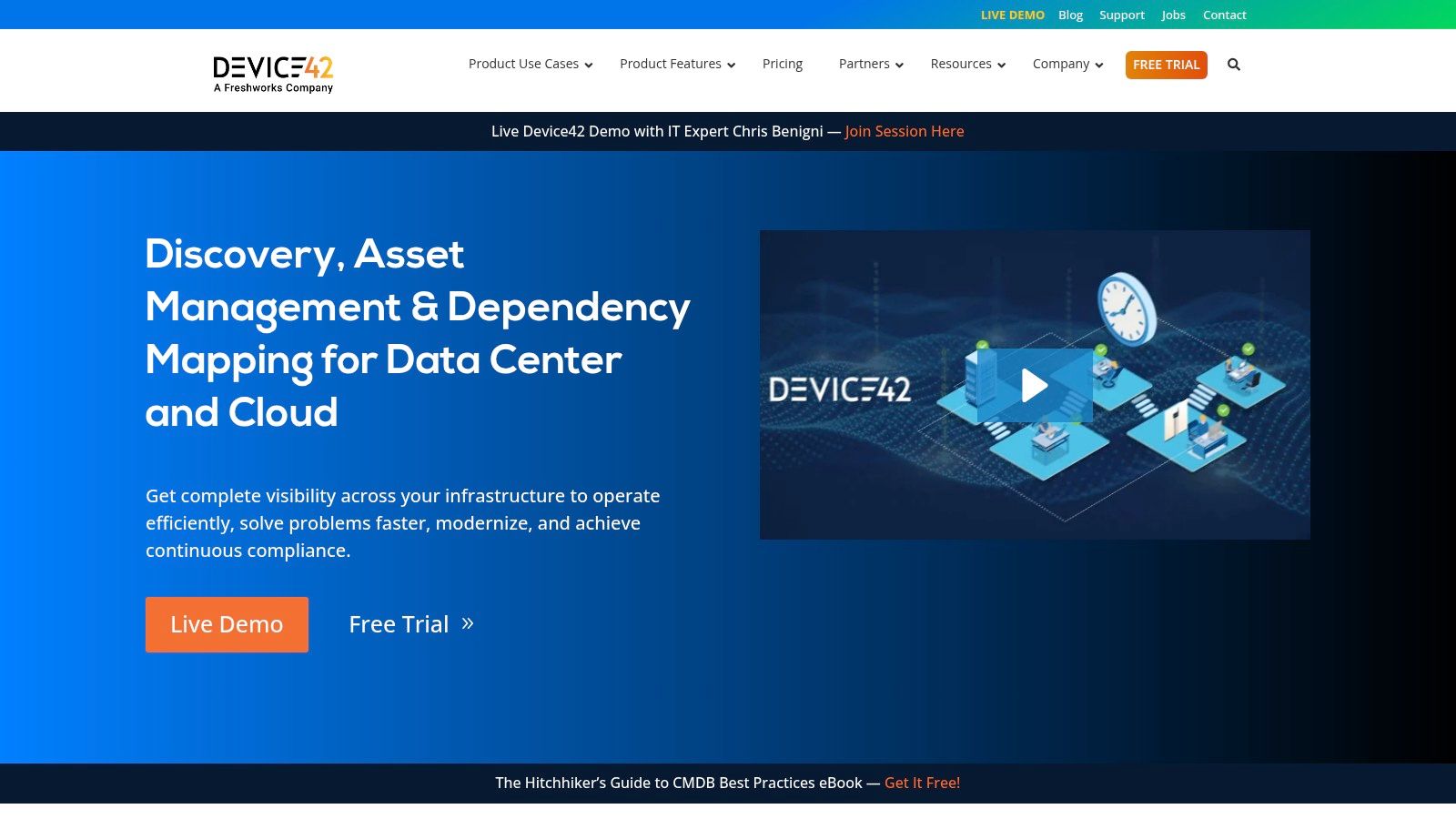
The platform's core strength is its agentless discovery, which scans the network to map out every component and its relationships. This data feeds into its affinity grouping feature, which automatically bundles interdependent servers and applications into logical "move groups." This technical insight is invaluable, preventing the common migration pitfall of moving a server only to find a critical dependency was left behind. It transforms migration from guesswork into a data-driven, strategic process.
Key Features & Use Cases
- Application Dependency Mapping: Automatically visualizes all TCP/UDP connections between applications and infrastructure, enabling the creation of technically sound move groups.
- Cloud Recommendation Engine: Analyzes discovered workload utilization to provide rightsized instance recommendations for AWS, Azure, and Google Cloud, helping to prevent overprovisioning and control costs.
- Move Group Planning: Allows users to build, validate, and schedule migration waves based on the discovered dependency data, streamlining project management.
- Integration with Mover Tools: Natively integrates with AWS Migration Hub and Azure Migrate, allowing you to export your planned move groups directly to the execution tools.
Pricing & Implementation
Device42 is a commercial tool with pricing that is typically based on the number of devices under management. Specific pricing details are available through a direct quote from their sales team or via the AWS Marketplace, where it can be procured directly. It is deployed as an on-premises virtual appliance, giving organizations full control over sensitive discovery data.
| Pros | Cons |
|---|---|
| Provides strong pre-migration visibility for complex environments. | Not a migration execution tool; requires pairing with a mover tool. |
| Agentless discovery simplifies deployment and reduces overhead. | Pricing details are not publicly listed and require a direct inquiry. |
| On-premises deployment keeps sensitive discovery data controlled. | Initial setup and network configuration can be complex in segmented environments. |
Best for: Medium to large enterprises with complex, poorly documented legacy environments who need to perform a thorough pre-migration assessment. It is an essential planning tool for organizations looking to minimize risk and optimize cloud costs from day one of their migration.
11. AWS Marketplace – Migration Solutions
The AWS Marketplace serves as a centralized digital catalog, not as a single tool, but as a curated hub for discovering, procuring, and deploying a vast array of third-party migration software. It simplifies the often-complex process of sourcing specialized tools for assessment, workload mobility, and data transfer by integrating them directly into the AWS billing and governance ecosystem. This makes it an essential resource for teams looking for the best cloud migration tools that fit specific technical needs while maintaining procurement consistency.
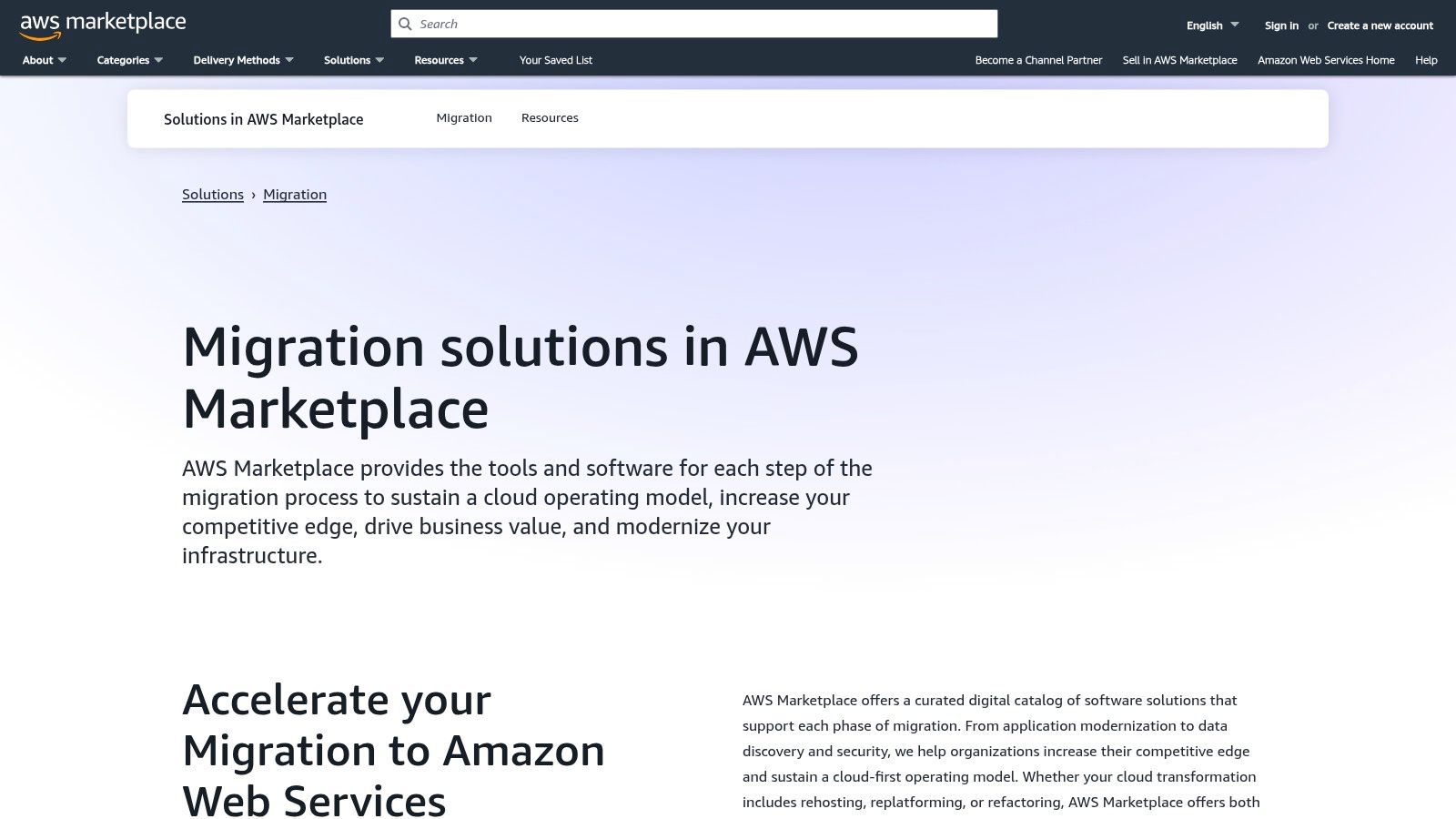
Instead of vetting and onboarding multiple vendors individually, engineering leaders can use the Marketplace to find solutions from providers like RiverMeadow, Flexera, and Tidal. The platform offers a unified procurement experience, allowing organizations to leverage existing AWS commitments, such as the AWS Migration Acceleration Program (MAP), to offset software costs. This streamlines the financial and operational overhead associated with multi-tool migration strategies.
Key Features & Use Cases
- Diverse Tool Selection: The marketplace lists software across all migration phases, including application discovery, data mobility, project monitoring, and cost management.
- Integrated Procurement: Offers flexible purchasing options like Pay-As-You-Go (PAYG), private offers, and standard SaaS contracts, all consolidated on a single AWS bill.
- Simplified Deployment: Many listed solutions feature 1-Click deployment or automated setup via AWS CloudFormation templates, significantly reducing initial configuration time.
- Governance and Control: Enables organizations to use AWS Identity and Access Management (IAM) and procurement policies to control which tools are available to their teams.
Pricing & Implementation
Pricing is determined by the individual third-party vendors whose products are listed on the Marketplace. Models vary widely, from hourly PAYG rates to annual SaaS subscriptions. The primary benefit is the unified billing through your AWS account, simplifying vendor management. Implementation varies by tool but is often accelerated by pre-configured deployment options available directly through the Marketplace interface.
| Pros | Cons |
|---|---|
| Centralized discovery and procurement of diverse migration tools. | Heavily focused on solutions for migrating workloads into AWS. |
| Streamlined billing and governance integrated with AWS. | Not an exhaustive list; some migration tools may not be available. |
| Potential to use AWS spending commitments (like MAP) for costs. | Requires careful evaluation to choose the right tool for the job. |
Best for: Organizations already operating within the AWS ecosystem that need to source specialized third-party migration tools without the overhead of separate procurement and billing cycles. It is ideal for teams building a tailored, multi-vendor migration toolkit.
Visit AWS Marketplace – Migration Solutions Website
12. Google Cloud Marketplace
While not a standalone tool, the Google Cloud Marketplace is a critical hub for organizations planning a migration to Google Cloud Platform (GCP). It serves as a centralized, curated platform for discovering, procuring, and deploying third-party migration software and professional services that are validated for the GCP ecosystem. This approach simplifies procurement by consolidating billing through a single GCP account and streamlines the discovery of specialized solutions.
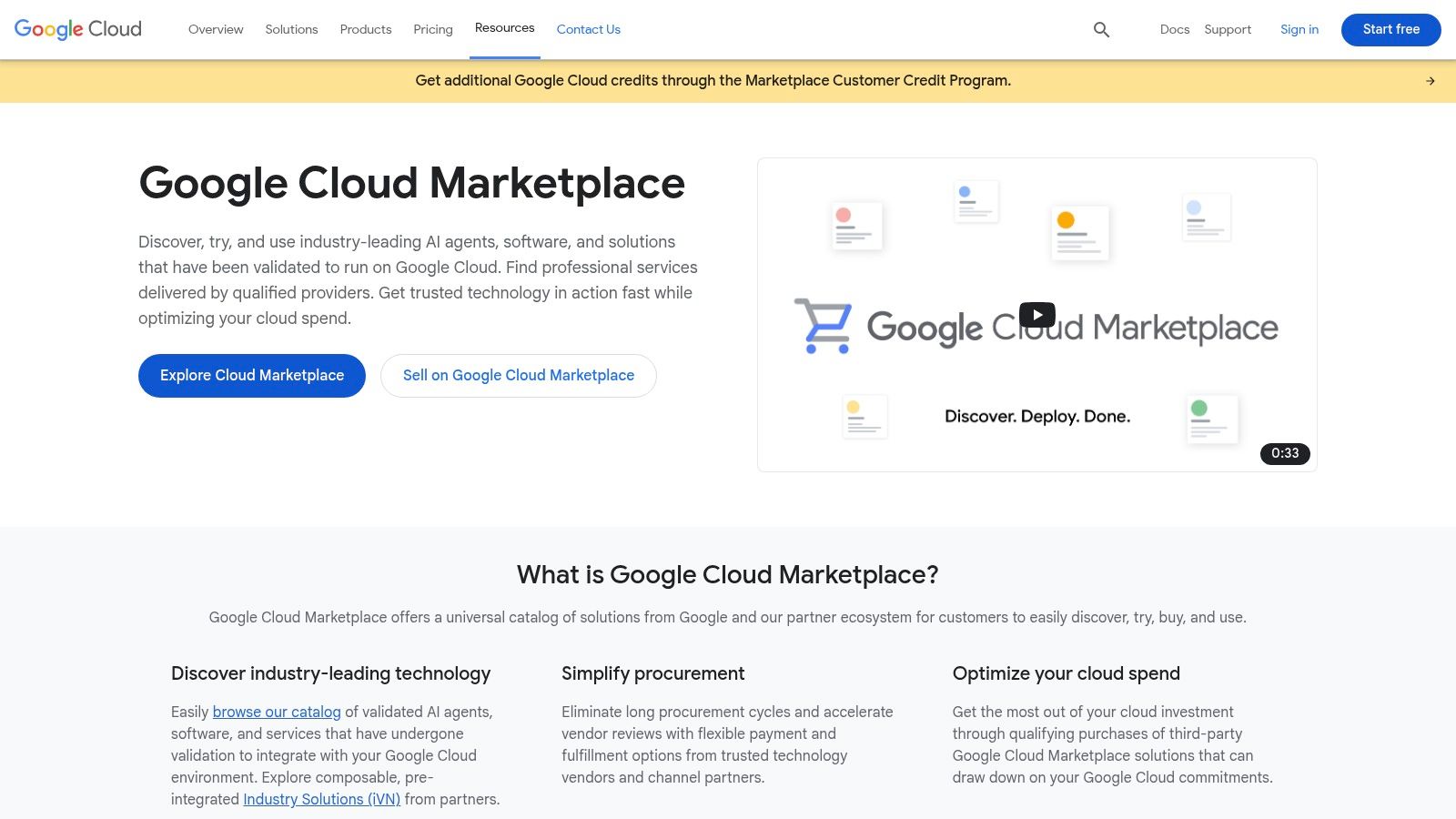
The marketplace provides a direct line to powerful third-party tools like RackWare Management Module for lift-and-shift migrations or professional services from certified Google Cloud partners. For technical teams, this means having a single, trusted source to find solutions that are pre-configured and optimized for GCP, reducing the risk and complexity of integrating external tools. The ability to apply marketplace purchases against existing GCP spending commitments is a significant financial incentive for enterprises.
Key Features & Use Cases
- Diverse Tooling Catalog: Offers a wide range of migration tools, from VM migration and disaster recovery solutions to database replication software, available as VMs, SaaS, or GKE applications.
- Integrated Procurement: Simplifies the purchasing process with consolidated billing through your GCP account, enabling streamlined budget management and governance controls.
- GCP Commitment Spend-down: Eligible purchases made through the marketplace can be applied toward your organization's committed use discounts with Google Cloud.
- Professional Services Integration: Connects you with certified migration specialists and consulting partners to assist with planning and execution, directly within the same platform.
Pricing & Implementation
Pricing varies significantly as the marketplace hosts products from numerous independent vendors. Each listing details its own pricing model, which can be pay-as-you-go, subscription-based, or bring-your-own-license (BYOL). Implementation involves selecting the desired tool or service and deploying it directly from the marketplace into your GCP project, often with just a few clicks.
| Pros | Cons |
|---|---|
| Consolidated billing and flexible procurement options. | Tightly coupled to the GCP ecosystem; not a cloud-agnostic platform. |
| Broad catalog including migration specialists and professional services. | Some niche or newer tools may still be sold directly by vendors outside the marketplace. |
| Access to pre-validated and optimized solutions for GCP. | Discovering the right tool among many options can still require significant research. |
Best for: Organizations committed to a Google Cloud migration that need a streamlined way to find, purchase, and deploy a wide range of third-party tools and services while leveraging their existing GCP financial commitments.
Visit Google Cloud Marketplace Website
Top 12 Cloud Migration Tools Comparison
| Solution | Core Features | User Experience & Quality | Value Proposition | Target Audience | Price Points / Licensing |
|---|---|---|---|---|---|
| AWS Application Migration Service (AWS MGN) | Block-level replication, automated EC2 conversion | Deep AWS integration, multi-account | Minimizes downtime, AWS-native | AWS-focused migrations | Costs for AWS resources during replication |
| Azure Migrate | Agentless discovery, dependency mapping, cost est. | Central dashboard, guided workflows | Free assessments, first-party integrations | Azure migration users | Free basic use; replication fees may apply |
| Google Cloud Migration Center + Migrate to VMs | Estimation, assessment, test-clone, rollback | Centralized workflows, free migration service | Streamlined GCP migrations | Google Cloud users | Free migration service; standard GCP charges |
| VMware HCX | Bulk/live migration, network extension | Low downtime, VMware ecosystem | Large-scale vSphere migrations | VMware environments | Licensing varies by VMware bundle |
| OpenText Migrate (formerly Carbonite Migrate) | Byte-level replication, AWS/Azure/GCP/VMware support | Orchestrated cutovers, rollback | Multi-cloud, near-zero downtime | Enterprises with complex workloads | Pricing on request; portfolio complexity |
| Zerto (by HPE) – Migration & Workload Mobility | Continuous data protection, one-click rollback | Fast cutovers, testing safety nets | Vendor-agnostic, DR & migration unified | Enterprise cloud and on-premises | Enterprise licensing, can be costly |
| RackWare Migration (RMM) | Any-to-any replication, wave scheduling | Free assessment, delta sync | Flexible, multi-cloud migration | Large, hybrid or regulated migrations | Flexible licenses, marketplace available |
| RiverMeadow Workload Mobility Platform | Discovery, wave planning, managed/self-service | Fixed-price bundles, AWS Marketplace | SaaS/private options, jointly managed | VMware-to-AWS & modernization | Enterprise minimums; pricing not public |
| Flexera One – Cloud Migration & Modernization | Dependency mapping, TCO modeling, workload placement | Reduces risk and time in planning | Supports complex, hybrid cloud portfolios | Large enterprises | Enterprise licensing; execution tools separate |
| Device42 (Discovery, ADM, Move-Group Planning) | Dependency mapping, cloud recommendations | On-premises control, integrations | Pre-migration visibility | Complex infrastructures | Pricing via inquiry or marketplace access |
| AWS Marketplace – Migration Solutions | Discovery, mobility, data migration tools | Consolidated billing, 1-click deploy | Broad solution selection, streamlined procurement | AWS migration projects | PAYG, SaaS, private offers |
| Google Cloud Marketplace | SaaS, VM, GKE apps; procurement controls | Consolidated billing, flexible | Catalog of third-party migration tools | GCP migration projects | Aligned with GCP commitments |
Making the Final Call: How to Select and Implement Your Migration Toolset
Navigating the landscape of cloud migration tools can feel overwhelming, but making an informed choice is the critical final step in your journey to the cloud. We've explored a wide array of options, from the tightly integrated ecosystems of AWS, Azure, and Google Cloud to specialized third-party powerhouses like Zerto, RackWare, and OpenText Migrate. The key takeaway is that there is no single "best" tool; there is only the best tool for your specific technical requirements, operational constraints, and strategic goals.
Your decision hinges on a clear understanding of your current environment and your desired future state. The native hyperscaler tools, such as AWS Application Migration Service (MGN) and Azure Migrate, offer deep integration, simplified billing, and a lower barrier to entry for organizations already committed to a specific cloud. However, they can create vendor lock-in and may lack the cross-platform flexibility that multi-cloud strategies demand. This is where tools like VMware HCX and RiverMeadow shine, providing the abstraction layer needed to move workloads between disparate environments with greater consistency.
A Strategic Framework for Your Tool Selection
To move from analysis to action, your selection process should be a structured evaluation, not a gut feeling. A systematic approach will ensure you account for all critical variables before committing resources.
Here’s a practical framework to guide your final decision:
- 1. Finalize Your Migration Strategy: First, reaffirm your chosen migration path (Rehost, Replatform, Refactor). A simple "lift-and-shift" rehosting project has vastly different tooling needs than a complex application refactoring initiative. Tools like AWS MGN excel at rehosting, while discovery and planning platforms like Flexera One or Device42 are essential for mapping dependencies before a major refactor.
- 2. Define Your Technical Non-Negotiables: Create a checklist of essential technical capabilities. Do you require near-zero downtime using block-level replication, as offered by Zerto? Is agentless discovery a mandatory security requirement? Do you need to migrate physical servers, virtual machines, and containerized workloads? Answering these questions will immediately narrow your list of contenders.
- 3. Conduct a Total Cost of Ownership (TCO) Analysis: Look beyond the initial licensing fees. Factor in the cost of professional services, potential downtime during migration, and the engineering hours required for implementation and management. Remember that many native cloud tools are "free" to use, but you pay for the underlying resources consumed during the migration process.
- 4. Plan a Proof of Concept (PoC): Never commit to a tool without a hands-on trial. Select a small, non-critical application and execute a PoC with your top two or three tool candidates. This real-world test will expose unforeseen complexities and reveal which tool's workflow best fits your team's skillset.
Implementation: Beyond the Tool Itself
Selecting one of the best cloud migration tools is only half the battle; successful implementation is where value is truly realized. A disciplined project management approach is non-negotiable. To ensure a smooth transition and successful deployment of your chosen cloud migration tools, a comprehensive SaaS implementation checklist can prove invaluable. This structured approach helps guarantee that all stakeholders are aligned, security protocols are met, and user training is adequately addressed.
Ultimately, the right toolset acts as a powerful accelerator, reducing manual effort, minimizing risk, and ensuring your migration project stays on schedule and within budget. By methodically aligning your unique needs with the specific capabilities of the tools we've covered, you can move forward with confidence, transforming a complex technical challenge into a strategic business victory.
Executing a complex cloud migration requires more than just the right tools; it demands specialized expertise. For organizations seeking to augment their teams with elite, vetted DevOps and SRE talent, OpsMoon connects you with freelance experts who have deep experience with these migration platforms. Find the specialized engineering talent you need to ensure your cloud journey is a success at OpsMoon.
